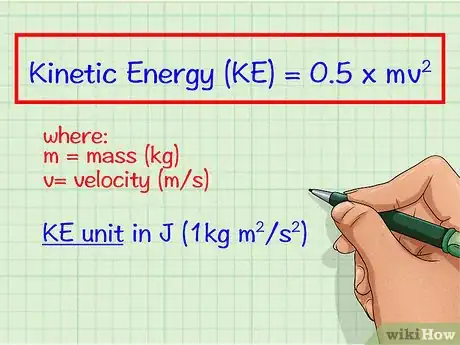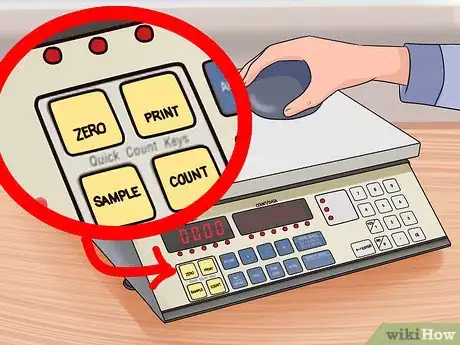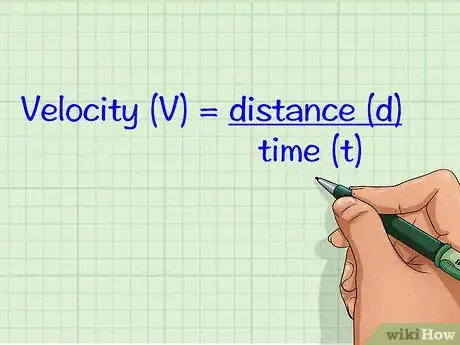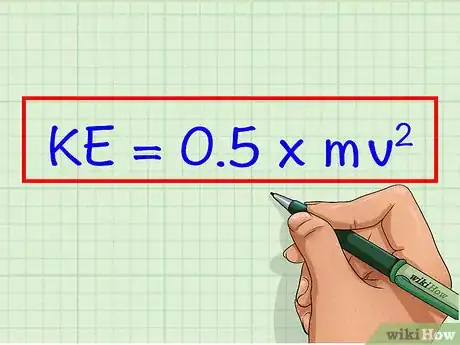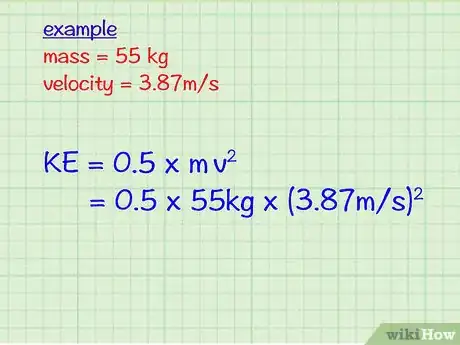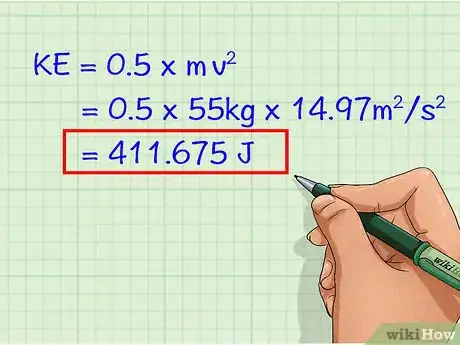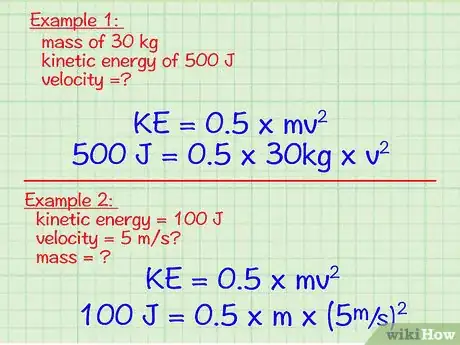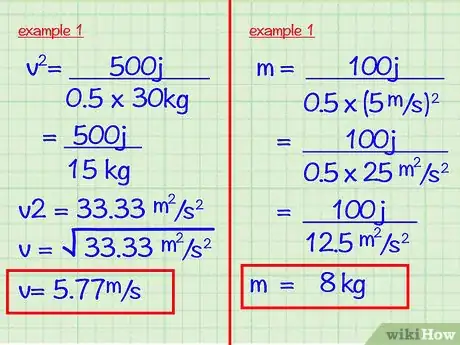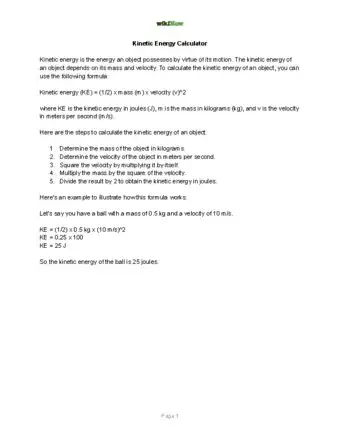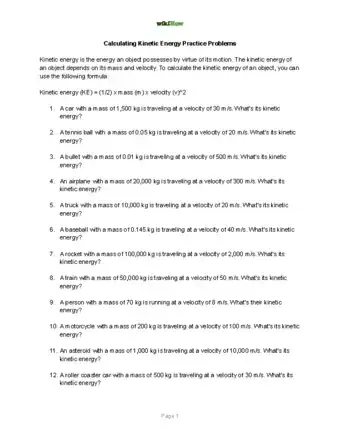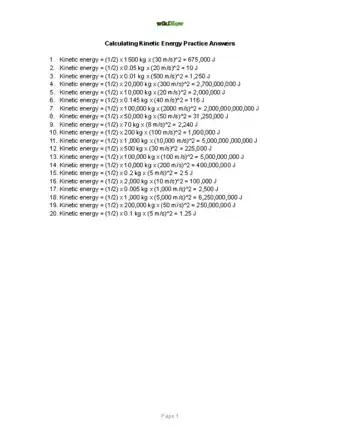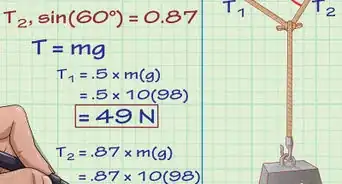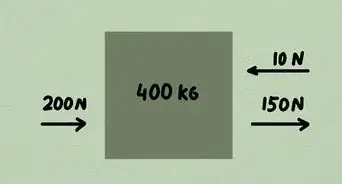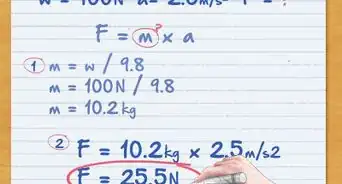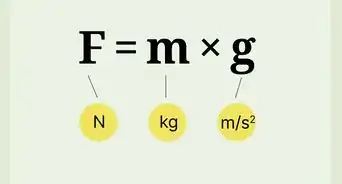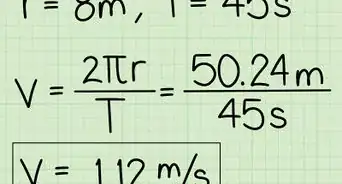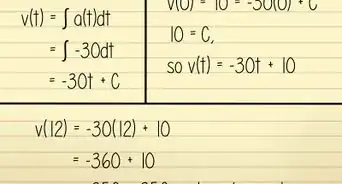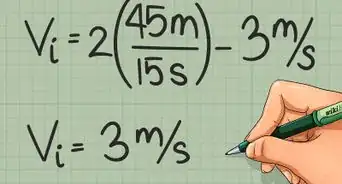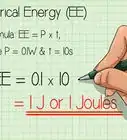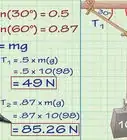This article was co-authored by wikiHow Staff. Our trained team of editors and researchers validate articles for accuracy and comprehensiveness. wikiHow's Content Management Team carefully monitors the work from our editorial staff to ensure that each article is backed by trusted research and meets our high quality standards.
This article has been viewed 1,049,067 times.
Learn more...
There are two basic forms of energy: potential and kinetic energy. Potential energy is the energy an object has relative to the position of another object.[1] For example, if you are at the top of a hill, you have more potential energy than if you are at the bottom of the hill. Kinetic energy is the energy an object has when it is in motion.[2] Kinetic energy can be due to vibration, rotation, or translation (movement from one place to another).[3] The kinetic energy of an object can easily be determined by an equation using the mass and velocity of that object.[4]
Steps
Understanding Kinetic Energy
-
1Know the formula for calculating kinetic energy. The formula for calculating kinetic energy (KE) is KE = 0.5 x mv2. Here m stands for mass, the measure of how much matter is in an object, and v stands for the velocity of the object, or the rate at which the object changes its position.[5]
- Your answer should always be stated in joules (J), which is the standard unit of measurement for kinetic energy. It is equivalent to 1 kg * m2/s2.
-
2Determine the mass of an object. If you are solving a problem where the mass isn’t given, you will have to determine the mass yourself. This can be done by weighing the object on a balance and obtaining the mass in kilograms (kg).
- Tare the balance. Before you weigh your object, you must set it to zero. Zeroing out the scale is called taring.[6]
- Place your object in the balance. Gently, place the object on the balance and record its mass in kilograms.
- If necessary, convert grams to kilograms. For the final calculation, the mass must be in kilograms.
Advertisement -
3Calculate the velocity of the object. Oftentimes, the problem will give you the velocity of the object. If this is not the case, you can determine the velocity by using the distance an object travels and how long it takes to cover that distance.[7] The units for velocity are meters per second (m/s).
- Velocity is defined by the equation, displacement divided by time: V = d/t. Velocity is a vector quantity, meaning it has both a magnitude and a direction. Magnitude is the number value that quantifies the speed, while the direction is the direction in which the speed takes place during motion.
- For example, an object’s velocity can be 80 m/s or -80 m/s depending on the direction of travel.
- To calculate velocity, simply divide the distance the object traveled by the time it took to travel that distance.
Calculating Kinetic Energy
-
1Write the equation. The formula for calculating kinetic energy (KE) is KE = 0.5 x mv2. Here m stands for mass, the measure of how much matter is in an object, and v stands for velocity of the object, or the rate at which the object changes its position.[8]
- Your answer should always be stated in joules (J), which is the standard unit of measurement for kinetic energy. It is equivalent to 1 kg * m2/s2.
-
2Plug the mass and velocity into the equation. If you don't know the mass or velocity of the object, then you'll have to calculate it. But let's say that you do know both quantities and are working to solve the following problem: Determine the kinetic energy of a 55 kg woman running with a velocity of 3.87m/s. Since you know the mass and velocity of the woman, you can plug it into the equation:[9]
- KE = 0.5 x mv2
- KE = 0.5 x 55 x (3.87)2
-
3Solve the equation. Once you've plugged in the mass and velocity, you can solve for kinetic energy (KE). Square the velocity and then multiply all of the variables together. Remember to state your answer in joules (J). [10]
- KE = 0.5 x 55 x (3.87)2
- KE = 0.5 x 55 x 14.97
- KE = 411.675 J
Using Kinetic Energy to Find Velocity or Mass
-
1Write the equation. The formula for calculating kinetic energy (KE) is KE = 0.5 x mv2. Here m stands for mass, the measure of how much matter is in an object, and v stands for velocity of the object, or the rate at which the object changes its position.[11]
- Your answer should always be stated in joules (J), which is the standard unit of measurement for kinetic energy. It is equivalent to 1 kg * m2/s2.
-
2Plug in the known variables. In some problems, you may know the kinetic energy and the mass or kinetic energy and velocity. The first step to solving this problem is to plug in all of the variables that are known.
- Example 1: What is the velocity of an object with a mass of 30 kg and a kinetic energy of 500 J?
- KE = 0.5 x mv2
- 500 J = 0.5 x 30 x v2
- Example 2: What is the mass of an object with a kinetic energy of 100 J and a velocity of 5 m/s?
- KE = 0.5 x mv2
- 100 J = 0.5 x m x 52
- Example 1: What is the velocity of an object with a mass of 30 kg and a kinetic energy of 500 J?
-
3Rearrange the equation to solve for the unknown variable. Using algebra, you can solve for the unknown variable by rearranging all of the known variables to one side of the equation.
- Example 1: What is the velocity of an object with a mass of 30 kg and a kinetic energy of 500 J?
- KE = 0.5 x mv2
- 500 J = 0.5 x 30 x v2
- Multiply mass by 0.5: 0.5 x 30 = 15
- Divide kinetic energy by the product: 500/15 = 33.33
- Square root to find velocity: 5.77 m/s
- Example 2: What is the mass of an object with a kinetic energy of 100 J and a velocity of 5 m/s?
- KE = 0.5 x mv2
- 100 J = 0.5 x m x 52
- Square the velocity: 52 = 25
- Multiply by 0.5: 0.5 x 25 = 12.5
- Divide kinetic energy by product: 100/12.5 = 8 kg
- Example 1: What is the velocity of an object with a mass of 30 kg and a kinetic energy of 500 J?
Calculator, Practice Problems, and Answers
Community Q&A
-
QuestionWhat is the kinetic energy possessed by a car having a mass of 1500 kg and travelling at a velocity of 50 km/h?
 Community AnswerRecalulate 50 km/h into m/s which is 13.889 m/s; then apply the formula: KE = 0.5 * 1500kg * (13.889 m/s)^2 = 144678 J => appr. 145 kJ
Community AnswerRecalulate 50 km/h into m/s which is 13.889 m/s; then apply the formula: KE = 0.5 * 1500kg * (13.889 m/s)^2 = 144678 J => appr. 145 kJ -
QuestionIf mass and velocity of body is doubled how can I figure out the change in kinetic energy?
 Community AnswerThe formula given for K.E. is K.E. = 0.5m(v^2). Doubling mass gives m = 2m. Doubling velocity gives v^2 = (2v)^2 =4v^2. Which makes K.E. 4 x 2 = 8 times bigger in total.
Community AnswerThe formula given for K.E. is K.E. = 0.5m(v^2). Doubling mass gives m = 2m. Doubling velocity gives v^2 = (2v)^2 =4v^2. Which makes K.E. 4 x 2 = 8 times bigger in total. -
QuestionWhat if the amount is in grams?
 Electric gearsCommunity AnswerIf it's in grams, you'll have to convert it to kilograms by dividing it by 1000. For example, 100g becomes 0.1kg, and 3g becomes 0.003kg.
Electric gearsCommunity AnswerIf it's in grams, you'll have to convert it to kilograms by dividing it by 1000. For example, 100g becomes 0.1kg, and 3g becomes 0.003kg.
References
- ↑ https://byjus.com/physics/potential-energy/
- ↑ https://www.khanacademy.org/science/physics/work-and-energy/work-and-energy-tutorial/a/what-is-kinetic-energy
- ↑ https://sciencing.com/sources-of-kinetic-energy-12298540.html
- ↑ https://byjus.com/physics/potential-energy/
- ↑ https://www.khanacademy.org/science/physics/work-and-energy/work-and-energy-tutorial/a/what-is-kinetic-energy
- ↑ https://study.com/academy/lesson/tare-weight-vs-net-weight.html
- ↑ http://www.physicsclassroom.com/class/1DKin/Lesson-1/Speed-and-Velocity
- ↑ http://www.physicsclassroom.com/class/energy/u5l1c.cfm
- ↑ http://www.physicsclassroom.com/class/energy/u5l1c.cfm
About This Article
To calculate kinetic energy, write out a formula where kinetic energy is equal to 0.5 times mass times velocity squared. Add in the value for the mass of the object, then the velocity with which it is moving. Solve for the unknown variable. Your answer should be stated in joules, or J. If you want to learn how to solve velocity or mass using kinetic energy, keep reading the article!
